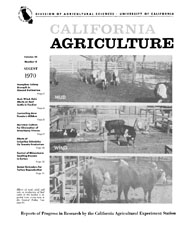


University of California
California Agriculture
|
|||
|
|||

Cover:
Effects of mud, wind, and rain on production of beef cattle in the feedlot is reported from recent tests in the Central Valley.
August 1970
Volume 24, Number 8 |
|||
|
University of California, 1301 S. 46th St., Bldg. 478 Richmond, CA
|